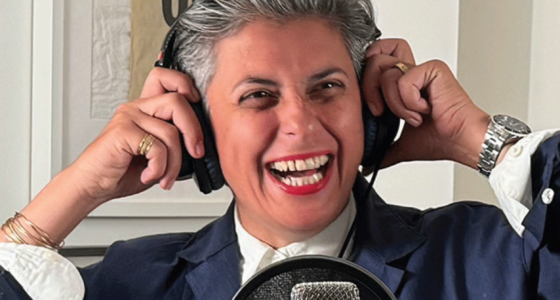Live journalism invites audiences to question the story in real time

Rochelle Raveendran’s nervousness subsides as she sees audience members begin to take their seats in the Players’ Guild of Hamilton Inc. theatre. She’s seated in a chair right next to the stage, level with the audience, while a saxophonist plays. The show begins. “Hello, everyone. Welcome to Harmed in Hamilton. My name is Rochelle,” she says. After three acts, she’s completed her first live journalism show at the Hamilton Fringe Festival.
Live journalism is the process of taking works of journalism and bringing them to life through live performance. This format takes the reporting practices of journalism and presents them using theatrical conventions. Live journalism can range from personal narrative storytelling to broader topics resembling a TED Talk. The International Live Journalism website describes it as “an expansion on traditional storytelling formats without the constraint of a page or a soundbite.”
Live Journalism and Rebuilding Trust
Harmed in Hamilton is a production of stitched!, a live journalism research and creative lab at Toronto Metropolitan University (TMU). It was founded in 2019 by TMU assistant professor Sonya Fatah, who develops and performs live journalism. Harmed in Hamilton was first performed in 2022, but Raveendran was part of a revised performance the following year. “So many times, you just publish a story, and it’s out, and then it kind of dies,” she says. “But with live journalism, you’re presenting the story, and you’re engaging with the audience and with the readers basically in real time.”
Raveendran adds, “You’re being held accountable for your reporting, and you’re seeing how they’re digesting it and responding to it. You can ask them questions and they can ask you questions, and that open dialogue is so unique in journalism.”
According to the Reuters 2023 Digital News Report, trust and consumption of traditional media like TV and print have been falling. Their data also show that online consumers are accessing news less often, with 48 percent saying they are very or extremely interested in news, a 15 percentage point decrease from 2017.
Live journalism allows journalists to rebuild trust between themselves and the community. “We often talk about what we call the antitheatrical prejudice, which is this long-standing idea—centuries old—that anything theatrical is inherently deceptive,” says Jordana Cox, an assistant professor at the University of Waterloo. “On the other hand, theatre is also a tradition of assembly; of gathering people together around stories.”
Cox’s book, Staged News: The Federal Theatre Project’s Living Newspapers in New York, published in February 2023, explores the relationship between news and theatrical performance in America during the Great Depression. In the 1930s, the Federal Theatre Project developed a production called Living Newspapers, which was the process of performing works of journalism as a theatre production. Cox says these productions were experiments in journalism during a time when trust in journalism was low. The FTP Living Newspapers were sprawling productions with big casts, teams of reporters, fact-checkers, and reference librarians working together to create a series of plays about the New Deal initiatives put in place during the Great Depression. “Americans had just seen this systemic, huge, nationally funded propaganda campaign that sent them to their deaths, essentially, in World War I,” Cox says, “so there was all this public consciousness around propaganda.”
Raveendran echoes a similar sentiment: that someone has the option to participate in live journalism when their faith in traditional journalism is dwindling. She, herself, was tired of how traditional mainstream media produced news. Live journalism presented her with the opportunity to look at her work as a journalist differently. This way, the audience is able to understand the story from the journalists’ perspective, providing feedback and their own perspectives.
The Mechanics of Community-based Journalism
Raveendran says that Harmed in Hamilton explores systems of harm in Hamilton schools and the discrimination students face based on their stories. Its production began when Fatah and her researchers investigated anti-bullying policies and daily incidents of bullying after a student died outside of a Hamilton school. The stitched! team interviewed former students, parents, and family members as well as used testimonies students gave to a youth organization and presented in the production.
The unique element of the show is Raveendran’s role as Community Gatherer, a role introduced in TMU’s Live Journalism course in 2023. According to Raveendran, not every live journalism production has this role—it is specific to stitched! “The community gatherer role is a journalistic role and the purpose of it is to engage with audiences before, during, and after a production,” she says. The community gatherer facilitates conversations, breaking down complicated subjects into digestible information by encouraging reflection and connections within the audience. “The purpose is community outreach and to create room for open dialogue between the journalist and community members,” says Raveendran. During production, she continues, inviting community members to contribute to the conversation requires a lot of effort. The community gatherer introduces herself and the production, and reminds the audience that she will be asking them questions throughout.
The Living Newspapers production did something similar in the ’30s, Cox says. While a show was in production, audience members would be invited to come to their head offices to consult sources or suggest corrections, reflected through script iterations with citations. Cox says that Living Newspapers was not aiming to approach storytelling, objectivity, or impartiality as traditionally defined by the American Society of News Editors’ 1923 Canons of Journalism. The project, however, was still trying to report systematically. Cox says that within productions of live journalism, the journalists and fact checkers are researching, analyzing, organizing, and then subjecting that analysis to multiple levels of interpretation. As a result, directors and actors interpret and frame a piece throughout the performance.
Cox explains that while this is an innovative approach to reporting, it can sometimes be a double-edged sword due to the possibilities for audience responsiveness. Raveendran recalls after one performance of Harmed in Hamilton, an emotional member of the audience approached her, hands shaking. They had found the show to be biased, omitting teachers’ voices.
Raveendran continues to report and research with stitched! At the moment, part of her duties include interviewing past audience members to understand if the community gatherer role was effective. She likes the element of live journalism that focuses on solutions. “It was a good way to remember priorities for me as a journalist,” she says. “The process of prompting dialogue, connections, and reflections—that in itself is a tangible outcome.”
About the author
Sahaana Ranganathan is a second-year Master of Journalism student at Toronto Metropolitan University. She’s produced segments for TVO’s the Agenda with Steve Paikin, does research for the Investigative Journalism Bureau and is the Art Director for The Otter. She’s passionate about combining arts, culture with social justice.







